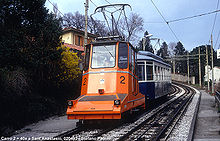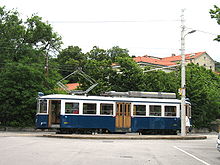- Opicina Tramway
-
Opicina Tramway 
Opicina Tramway, on the cable hauled section. The port of Trieste can be seen in the background.Info Locale Trieste, Italy Transit type Hybrid tram / funicular Number of lines 1 Number of stations 13 Operation Began operation 1902 Operator(s) Trieste Trasporti Number of vehicles 8 tramcars + 2 cable tractors Technical System length 5.2 km (799 metre cable section) Track gauge 1,000 mm (3 ft 3 3⁄8 in) The Opicina Tramway (Italian: Tranvia di Opicina, Slovene: openski tramvaj, Triestine: Tram de Opcina) is an unusual hybrid tramway and funicular railway in the city of Trieste, Italy. It links Piazza Oberdan, on the northern edge of the city centre, with the village of Villa Opicina in the hills above.[1]
For most of the journey, the line operates as a conventional, electrically powered tramway, with a mixture of street running and reserved track. On the steepest section of the line, between Piazza Scorcola and Vetta Scorcola, the trams are pushed uphill and braked downhill by a pair of cable tractors that operate on funicular principles.[2]
The line forms part of the network of Trieste Trasporti, the public transport operator for Trieste, and operates as line 2 of that operator. The line operates every 20 minutes from early morning (07:00) to early evening (20:00).[3]
Contents
History
As a rack and adhesion line
Although the South railway first arrived in Villa Opicina in 1857, its railway station was situated some distance from the village, and the local topography forced a circuitous 32 km railway route between Opicina and Trieste. As a result various projects were promoted to link the two places more directly, resulting eventually in the construction of the Opicina Tramway by the Società Anonima delle Piccole Ferrovie di Trieste.[1][2]
The line was opened in 1902, and as built incorporated a rack railway section between Piazza Scorcola and Vetta Scorcola. Conventional four wheel tramcars operated the full length of the line, being assisted up and down the rack section by three small rack locomotives. In 1906 the line was extended at its top end from the village of Villa Opicina to Villa Opicina station, a distance of 1.2 km.[2]
As a hybrid funicular and tramway
In 1928 the rack railway section was replaced with a funicular section, and the rack locomotives by cable tractors. However the original four wheel trams continued running until 1935, when they were replaced by new bogie cars. The extension to Villa Opicina station was closed in 1938. After nearly 60 years of private ownership, the line was taken over by the municipality of Trieste in 1961.[1][2]
The line has been modernised several times over the years, most recently in 2005 and 2006. However it still uses the four of the five 1935 built tram cars, supplemented by two similar cars built in 1942. Two of the original four wheel cars have survived, and one sees occasional use as an operational museum car. New unmanned cable tractors were provided at the most recent rebuild, which are remotely operated by the tram drivers.[1][2][4]
Route
Description
The line has a total length of 5.2 km, and climbs from just 3 metres above sea level in Trieste to a height of 329 metres in Opicina. The line is of metre gauge, and is single tracked with eleven intermediate stops and four passing loops. The terminus in Piazza Oberdan has two tracks, although only one is normally used. Between Piazza Oberdan and Piazza Scorcola, a distance of some 400 metres, the line runs in the street along the Via Martiri Della Libertà through a built up urban area.[1]
From Piazza Scorcola to Vetta Scorcola, a distance of 869 metres, the funicular section runs on its own right of way. The actual cable hauled section is 799 metres long and climbs a vertical distance of 160 metres with a maximum gradient of 26%. In the middle of the funicular section is the first passing loop, at Romagna, which is used in normal service. Whilst the line below the passing loop is single track, the track above the loop is interlaced double track. There is a short stub at the lower terminus that permits the cable tractor to avoid blocking the running line.[1]
The longer upper section, from Vetta Scorcola to Villa Opicina, is mostly on roadside reservation or private right-of-way in open rural country. There are three passing loops on this section, although only the one at Conconello is used in normal service, with the loops at Cologna Campo Sportivo and Campo Romano only used only if extra cars are running. The terminus at Villa Opicina is flanked by a five track depot.[1]
Stops
From the Trieste end of the line, the line serves stops at:[4]
- Piazza Oberdan (terminus)
- Piazza Scorcola
- Sant' Anastasio
- Romagna
- Vetta Scorcola
- Cologna Campo Sportivo
- Cologna Chiesetta
- Conconello
- Banne
- Obelisco
- Campo Romano
- Via Nazionale
- Villa Opicina (terminus)
Equipment
Tramcars
The line is operated by six steel-bodied four-axle electric tramcars numbered 401-402 and 404-407. Cars 401-405 were built in 1935 by Officine Meccaniche Stanga with Tecnomasio Italiano Brown Boveri electrical components. Cars 406-407 were built in 1942 by the same companies to a similar design, although war-time shortages resulted in a more basic interior and different window detail. Car 403 was subsequently destroyed in an accident.[1][4]
The cars take electricity from a 550 Volts DC overhead line. Each car is 13.37 metres long, 2.5 metres wide and 3.45 metres high, with 50 seats and a total carrying capacity of 120 passengers. They have four 25 kW motors, giving a maximum speed of 35 km/h, and are equipped for rheostatic braking, in addition to air brakes, electro-magnetic track brakes and hand brakes.[1][4]
Two of the original wooden-bodied four-wheel tramcars still exists. The original car 1 was built in 1902, at Graz in Austria, by Grazen Union Fabrik with electrical components from Osterreichische Union Elektrizitäts Gesellschaft. On the arrival of cars 401-407, it was converted into a works car numbered 411. In 1992 it was restored to its original condition and sees occasional service as a museum car. Car 6 has also survived and been recently restored, having been displayed as a static exhibit at the railway museum in Trieste Campo Marzio station.[1][4]
Cable tractors
On the funicular section of the line, the tramcars are pushed uphill and braked downhill by cable tractors, also known as cable dummies or, in Italian, carro scudo. These vehicles are permanently attached to the haulage cable. They are not attached to the tramcars, but the lower end of the tramcar rests against the upper end of the cable tractor. There have been three generations of cable tractors on the line.[1]
The first generation of cable tractors were introduced in 1928, and had 4.7 metre long box shaped bodies. These cars were replaced in 1978 by two new vehicles, numbered 1 and 2. These had a very different appearance, with only a short control cabin in the centre of the 4.98 metre long chassis. Both these first two generations of cable tractor were operated by their own driver, distinct from the driver of the tramcar.[1]
In 2005, a third generation of unmanned cable tractors was introduced. These tractors are operated remotely by the drivers of the tramcars. Without the need for a cabin to accommodate a driver, these new cable tractors are low profile vehicles, and thus do not obstruct the vision of the tramcar driver when running downhill with the tractor leading.[2]
References
- ^ a b c d e f g h i j k l Gillham, John; Jelercic, David (January 2003). "Trieste: Hundred years of loyal service". Tramways & Urban Transit (Ian Allan Ltd / Light Rail Transit Association). http://lrta.info/articles/art0301.html. Retrieved 7 December 2010.
- ^ a b c d e f Ammann, Christian; Juvanec, Maj (May 2007). "Discovering Trieste". Today's Railways (Platform 5 Publishing Ltd): pp. 29–31.
- ^ "Timetable" (PDF). Trieste Trasporti. Archived from the original on September 27, 2007. http://web.archive.org/web/20070927174309/http://www.triestetrasporti.it/ttspa/pages/ita/tpl/orari/orainv/pdf/ORA02NFE.PDF. Retrieved April 23, 2007.
- ^ a b c d e "Trieste - Villa Opicina Tram Line". Trieste Trasporti. http://www.tramdeopcina.it/tram/pages/tt2engl.htm. Retrieved April 24, 2007.
External links
Categories:- Tram transport in Italy
- Trieste
- Transport in Friuli-Venezia Giulia
- Rack railways in Italy
- Funicular railways in Italy
- Metre gauge railways in Italy
Wikimedia Foundation. 2010.








